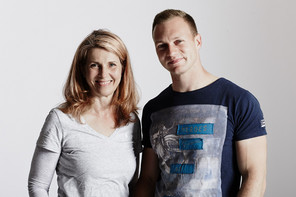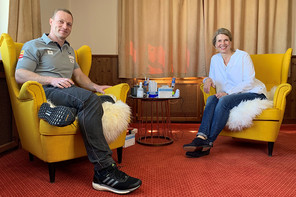Tuesday, 15. September 2020
Brigitte Schmailzl, physiotherapist for the German bobsleigh team and for the Reference Centre for Respiratory Therapy in Sport talks about how inhalation therapy is an important factor in virus protection.

Brigitte Schmailzl: Professional athletes are especially susceptible. Their immune system is stretched to the limit. More than half of the athletes who visited a doctor during the 2014 Olympic Games in Sochi did so for respiratory disease. My job is to look after the athletes’ health and to ensure that they don’t catch an infection during the championship season.
Brigitte Schmailzl: Well, at first, it wasn’t all that easy. When I first started, I took in what was going on and then I asked “Hey, aren’t you using sinus flushes”? They all had a good laugh. The general feeling was kind of “what is she on?”. But that soon changed. I remember when Francesco Friedrich did a sinus flush for the first time with his push athletes around him. When he then blew his nose and said “Wow, that’s much better”, they all suddenly stopped laughing.
Brigitte Schmailzl: Not just that. Saline inhalation is another important aspect. Inhalation with saline solution prevents the mucous membranes from becoming too dry, which can let viruses take hold. Ideally, everyone in the team should do it because inhalation with saline solution or with ectoin gives you an extra layer of protection against corona viruses, for example. I am one hundred percent certain that vulnerable groups can protect themselves from infections with saline inhalation.


Brigitte Schmailzl: When athletes train at high altitudes, such as Salt Lake City, St Moritz, and so on, where the air is really dry at 1500-2300 meters, the nasal passages simply become dry and that makes them more susceptible to viruses. That’s what happens to all of us, by the way, in the winter when the central heating dries out the air. The team is often huddled together in a small space; all it takes is for one of them to catch something and sneeze, and it spreads through the entire team.
Brigitte Schmailzl: For some of them, saline inhalation is now an essential. Their bodies have to cope with constant change: warm, cold, different levels of humidity. To prevent his nasal passages from dryness and to protect them, Francesco Friedrich uses the inhalation twice a day in winter, for instance. He is a perfectionist in everything he does, even when it comes to his health. He once told me he couldn’t manage without my advice, which of course pleased me. We also conducted a study which concluded that the team that constantly used this treatment were less likely to fall ill, and some did not fall ill at all. And of course, that shows in their performance. Even athletes from other nations have caught onto the idea and have asked me for support. But this isn’t something I just recommend to professional athletes, but to my practice patients too. I don’t know anyone who would not benefit from simple saline inhalation therapy.
Brigitte Schmailzl: Of course. Inhalation therapy can be helpful for any form of respiratory disease. Inhaling saline solution makes a massive difference in day-to-day life for these patients and in the progression of their disease. It specifically helps people who are unwell to cough up mucus and it improves the viscosity of the secretions. The treatment prevents the disease from progressing, improves performance and last but not least, improves a patient’s quality of life.
Brigitte Schmailzl: If you are looking for an inhaler to use at home, I recommend that you not only look at performance, but at the quality, reliability, and easy handling too. Often it’s the small things that can make a difference. If you open the package and it absolutely stinks, that’s not a very promising sign. How easy is it to clean the nebulizer and then to reassemble it? Can an elderly person manage it too? How reliable is the device when you use it and is there someone to help you if something goes wrong? I believe these are often really important considerations and I am sure that other respiratory physiotherapists will agree with me. First and foremost, the patient has to be able to handle the device so that the therapy can be done properly at home. In my practice, I like to combine modules for respiratory physiotherapy, like PEP systems or nebulizers with PIF Control, which encourages an effective inhalation technique. If they are available with the device or can be easily combined and spare parts are available for a long time, so much the better.
Note: The statements made in the interview are the individual views of the interviewee. They do not necessarily reflect the PARI view or the general state of science.
An article written by the PARI BLOG editorial team.
© 2024 PARI GmbH Spezialisten für effektive Inhalation